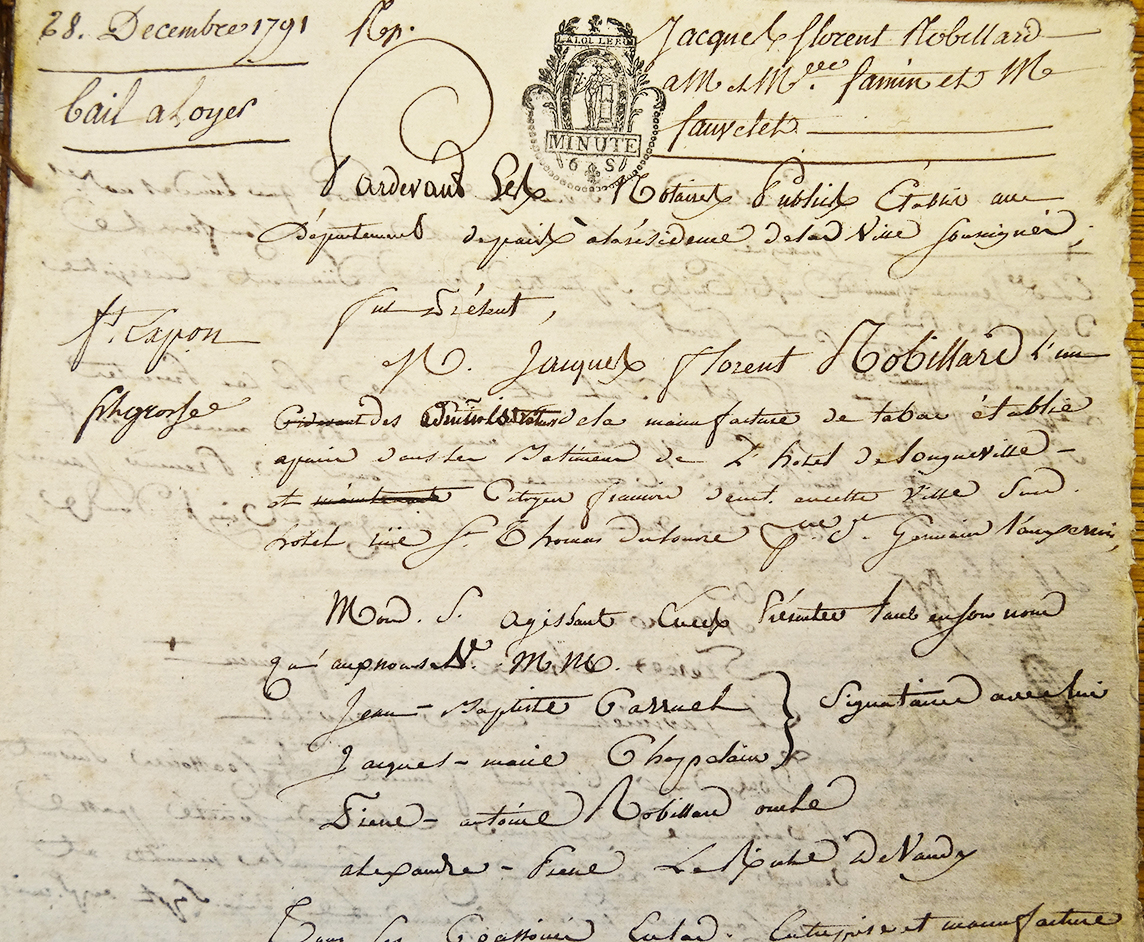1791 Robillard Tobacco Foundation
Géricault Life
Citoyen Détailleur au Citoyen Robillard Bail à Loyer, 1791 Sept. 23 (plan, detail) MC/ET/XCVI/558 Notaire Doillot. Image courtesy of the Archives Nationales (France)
1791 Robillard Tobacco Foundation
Three sets of archival records help us better understand the original Robillard tobacco concern and its creation in the fall of 1791. The first folder is F/12/1503/B Longueville tabac 1792, in the Archives Nationales (France). This folder contains two original documents which identify the Robillard “associés” (or partners) as Le Riche de Vandy; Caruel; Chapelain; Robillard; and Robillard, oncle.” The signatures of these individuals appear below on a document discussing the tobacco workers’ petition to the national assembly, dated March 22, 1792. We shall identify these partners more fully in due course. Most Géricault scholars know of this archive. None have published on F/12/1503/B, as far as I know, except to date the founding of the Robillard tobacco concern at the Hôtel de Longueville incorrectly as 1792, an entirely understandable error.

Associés de la manufacture du tabac de l’hôtel de Longueville à l’Assmblée Nationale, March 22, 1792 ( detail) Archives Nationales (France) F/12/1503/B. Image courtesy of the Archives Nationales (France)
Détailleur – Robillard Sub-Lease, September 23, 1791
Without access to the next two documents, dating the foundation of the Robillard tobacco concern is a challenge, but one worth the effort. The first of these is one we can accurately characterize as the “origin” document of the Robillard tobacco concern myth: the sub-lease Jean Marie Détailleur signed on behalf of the municipal authorities with Jacques Florent Robillard on September 23, 1791, which granted Robillard control of the tobacco manufactory at the Hôtel de Longueville in the Tuileries section of Paris, as well as other parts of this immense edifice. As we discussed in our earlier discussions of the founding of the Robillard tobacco concern, Jacques Florent Robillard was the sole signatory, or “preneur” of the sub-lease. See below.

Citoyen Détailleur au Citoyen Robillard Bail à Loyer, 1791 Sept. 23 (p.1, detail – continued below) MC/ET/XCVI/558 Notaire Doillot. Image courtesy of the Archives Nationales (France)

Citoyen Détailleur au Citoyen Robillard Bail à Loyer, 1791 Sept. 23 (p.1, detail – signatures below) MC/ET/XCVI/558 Notaire Doillot. Image courtesy of the Archives Nationales (France)

Citoyen Détailleur au Citoyen Robillard Bail à Loyer, 1791 Sept. 23 (detail -final page, signatures) MC/ET/XCVI/558 Notaire Doillot. Image courtesy of the Archives Nationales (France)
Robillard – Famin & Fauvelet Sub-Lease, December 28, 1791
The lease signed between Jacque Florent Robillard and M.M Famin and Fauvelet (of the National Auction House, or encan nationale), on December 28, 1791, confirms several facts about the early iteration of the Robillard tobacco concern in 1791. Jacques Florent Robillard is identifed as a ‘one of the administrators’ of the tobacco manufactory the Hôtel de Longueville, rather than the sole preneur, or entrepreneur, as he was in the September 23 sublease. We discover for the first time notarial evidence confirming the existence of at least four other co-associés: Jean Baptiste Carruel (sic) Théodore Géricault’s close maternal uncle; Jacques Marie Chapelain, Alexandre Le Riche de Vandy; and Pierre Antoine Robillard, oncle. The same individual family names appear in the F/12/1503/B documents.

Citoyen Robillard au M.M. Famin & Fauvelet Bail à Loyer, 1791 December 28, 1791 (detail ) MC/ET/XCVI/559 Notaire Doillot. Image courtesy of the Archives Nationales (France)
Commentary & Conclusion
All of the documents, or archives, we have identified are worth examing on their own merits. Together, they tell us something important about the Géricault family tobacco concern at the Hôtel de Longueville during its earliest iterations. The first and most important is that documentary evidence is scant, and in some sense, at least, unreliable. Unreliable because of the presence of silent partners almost certainly present and active prior to September 23, 1791, when Jacques Florent Robillard signed the sub-lease with Détailleur. We have identified four active as early as December 28, 1791. Were there others? Probably, but who?
To what extent did bid-rigging and/or financial impropriety figure in the granting of the lease to Jacques Florent Robillard in September of 1791, and in the restructuring of the Robillard tobacco concern several years later? Revolutionary police and the courts punished theft from tbe public purse with the guillotine. Several key figures involved in businesses at the Hôtel de Longueville suffered that fate. As we shall see, revolutionary authorities fixed their gaze upon the events we have just discussed in 1794. We shall investigate these and other questions elsewhere.
Théodore Géricault’s ability to pursue his interests and his inclinations was very much dependent on his family’s wealth. Had the investigations into Jean Marie Détailleur and others in 1794 followed a different path Géricault’s life likely would have changed dramatically. Indeed, had events run a different course, Théodore Géricault would have never left Rouen, opting instead to follow a safe career in the law like so many of the males in his family.